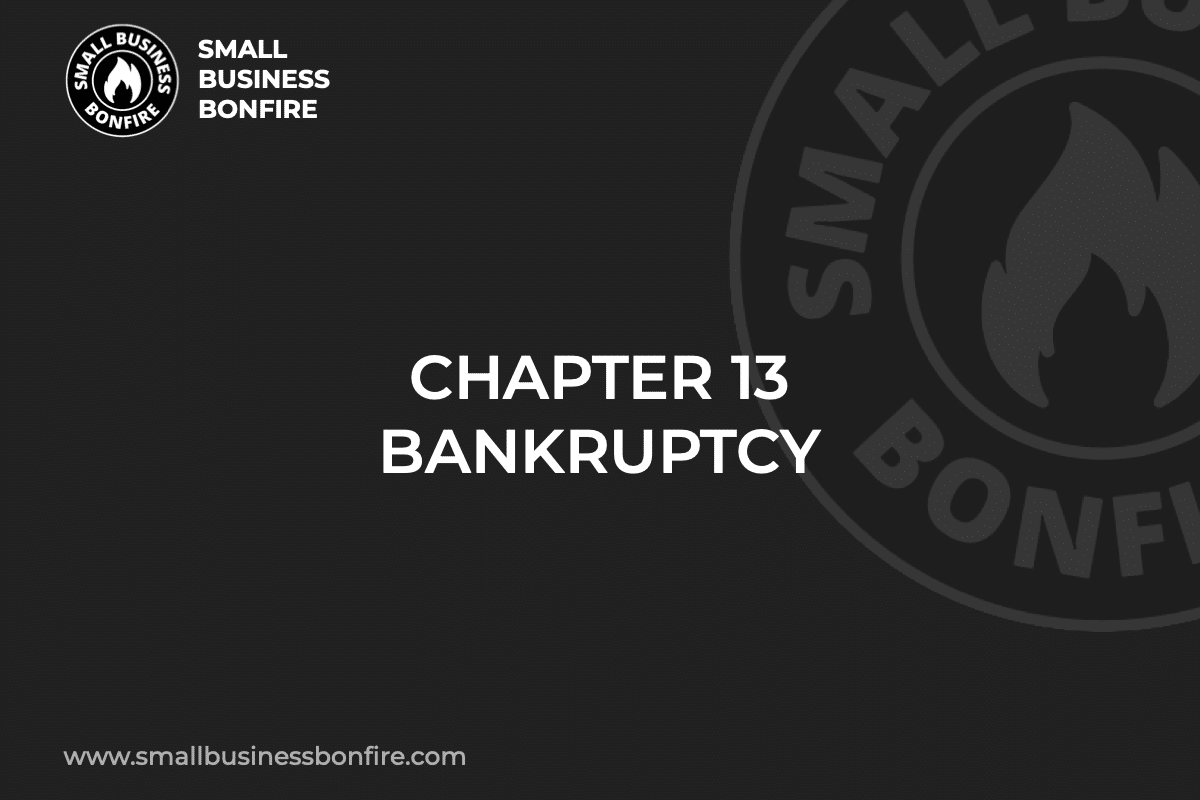Is your small business facing a mountain of bills you simply can’t keep up with? Your company still brings in money, but catching up on your debt seems impossible!
If this sounds like your situation, you’re not alone! Numerous companies have this problem.
Hi! My name is AJ! I recently sold my business for a multiple seven figures.
Now, I aim to help other entrepreneurs find success and understand the business world.
What do you need to know about Chapter 13? Keep reading! I’ll tell you everything you need to know!
Key Takeaways
- Chapter 13 bankruptcy is a viable option for small businesses facing financial hardship.
- Chapter 13 allows companies to restructure their debts and continue operations.
- Unlike Chapter 11, Chapter 13 is less complex and costly, making it more accessible for smaller enterprises.
- While Chapter 13 provides immediate relief and requires a court-approved repayment plan over 3 to 5 years.
What is Chapter 13 Bankruptcy for Businesses?
What is a small business bankruptcy Chapter 13 filing?
Chapter 13 bankruptcies allow companies to reorganize their debts and ultimately prevent them from going out of business.
Further, this type of bankruptcy allows businesses to keep their assets while paying off all or some of their business debts.
Typically, the company must create and be approved for a repayment plan that lasts between three and five years.
However, filing bankruptcy under Chapter 13 only works in a select number of instances.
How Chapter 13 Works for Businesses
A Chapter 13 bankruptcy filing allows small business owners to keep their company’s assets while reorganizing and paying their business debt.
The bankruptcy court assigns the company a bankruptcy trustee.
So, when a business makes monthly payments to settle its debt, the money goes to the trustee.
Then, the bankruptcy trustee pays secured and unsecured creditors according to the payment plan.
The amount of money businesses must pay back depends on the following things:
- Income
- Expenses
- The types of debt the company has (secured or unsecured debts)
The higher the business’s income, the more it must pay.
Still, there are some debts (priority debts) that companies must repay in full regardless of their income.
Some examples of priority debts include the following:
- Certain taxes
- Domestic support obligations
Business entities must show they have enough income to repay priority debts to qualify for this type of bankruptcy filing.
Chapter 13 Bankruptcy by Organizational Structure
Filing for Chapter 13 bankruptcy varies based on the type of business you run, such as:
- Sole proprietorship
- Partnership
- LLC/Corporation
Let’s see how Chapter 13 works for each of these business entities!
Sole Proprietor Files for Bankruptcy
A sole proprietorship is a business that one person owns and operates.
Being a sole proprietor and filing for Chapter 13 has many advantages.
How Chapter 13 Works for Sole Proprietors
If a sole proprietor falls behind one business’s debt payments, getting back on track by filing for bankruptcy is a viable choice.
In these cases, the sole proprietor files for Chapter 13 under their own name, NOT the business’s name.
Therefore, the individual reorganizes both their personal AND business debts.
Remember, sole proprietors aren’t separate entities like LLCs.
Therefore, the business owner is responsible for individual and business debts.
When filing for bankruptcy, the sole proprietor’s property and income are available to repay the company’s debt.
Advantages of Chapter 13 for Sole Proprietors
Some advantages of Chapter 13 bankruptcy for sole proprietors include:
- The business doesn’t have to close
- The company can keep its equipment
- The owner doesn’t (usually) have to pay other bills like energy bills, credit card statements, overdue invoices, etc.
Disadvantages of Chapter 13 for Sole Proprietors
On the other hand, some downsides of filing bankruptcy under Chapter 13 include:
- The business owner must treat business debts like personal debts
- The business may not qualify if it doesn’t have enough income
Partnership Files for Bankruptcy
Businesses that operate as partnerships are owned and operated by two or more people.
Typically, partnership business bankruptcy is stressful, but Chapter 13 is an option in some instances.
How Chapter 13 Works for Partnerships
When a small business that’s a partnership files for Chapter 13, it works similarly to a sole proprietorship.
Therefore, small business owners create a repayment plan for unsecured and secured debts.
Depending on the partnership agreement, certain owners might be responsible for repaying a larger percentage of the debts (because they own more business assets).
Another reason Chapter 13 is tricky for partnerships is because there are multiple owners’ personal debts to consider.
Advantages of Chapter 13 for Partnerships
Some pros of Chapter 13 for partnerships include:
- The business can stay open
- Owners (in some cases) don’t have to pay certain personal debts
- A partnership agreement ensures the debt relief plan is handled appropriately
Disadvantages of Chapter 13 for Partnerships
The cons of filing for Chapter 13 as a partnership include:
- It can deteriorate the working relationship between partners
- Some partners may have to pay more debt than others
- Some partners’ credit scores are negatively impacted
LLC or Corporation Files for Bankruptcy
LLCs and corporations are business entities that are entirely separate from the owner.
Therefore, when their company is an LLC or corporation, small business owners and their personal debt are unaffected by bankruptcy.
How Chapter 13 Works for LLCs & Corporations
Chapter 13 is not available for corporations or LLCs.
Instead, this type of bankruptcy is only available for sole proprietors (and some partnerships) with regular income.
Still, a small business owner operating an LLC or corporation can file for Chapter 13 under their name (not the business’s).
Advantages of Chapter 13 for LLCs & Corporations
Because LLCs and corporations cannot file for this type of bankruptcy, there aren’t any advantages to doing so.
Still, one Chapter 13 alternative for LLCs/corporations is filing for bankruptcy under Chapter 11.
An advantage of Chapter 11 is that there are no debt or income requirements or limitations for filing!
Disadvantages of Chapter 13 for LLCs & Corporations
Disadvantages of Chapter 13 for LLCs and corporations include:
- The business owner must take on the business debt on a personal level (if they file for bankruptcy under their name)
- These entities cannot file for Chapter 13 under the business’s name
Personal Liability for Corporate or LLC Debts
Often, when corporations or LLCs (limited liability companies) have business debt, the owner is personally liable.
There are various forms of personal liability, including:
- Trust fund taxes
- Alter ego claims
- Fraud claims
- Personal guarantees
Let’s analyze these liabilities in greater detail!
Trust Fund Taxes
Trust fund taxes are the taxes an employer withholds from an employee’s wages.
These taxes include:
- Income taxes
- Social security taxes
- Medicare taxes
When LLCs or corporations file for bankruptcy, the owner (or responsible person) is liable for any unpaid trust fund taxes when the owner chooses to liquidate the business.
Alter Ego Claims
An alter ego is when a bankruptcy court finds a corporation lacks a separate identity from individual or corporate shareholders.
Therefore, when individuals and LLCs or corporations mix assets, the business owner can be personally liable for their business’s debts.
In this situation, when an LLC or corporation files for bankruptcy, creditors can ask the court to ignore the corporate veil (that shields personal assets from business debt).
Fraud Claims
Fraud is another way creditors can hold individual owners responsible for business debt.
When a creditor asks the court to collect fraud claims, the business owner isn’t entitled to bankruptcy protection.
This scenario is rare because the burden of proof lies with the creditor.
Personal Guarantees
Lastly, there’s a personal guarantee.
This liability involves the small business owner agreeing to pay personal assets when they cannot repay a company’s debt.
In this case, avoiding responsibility is impossible if personal guarantees exist for business loans, credit cards, and equipment leases.
Chapter 13 Vs. Chapter 11 Bankruptcy
Chapter 13 and Chapter 11 bankruptcies serve distinct purposes and are suited for different kinds of debtors.
For example, Chapter 13 allows individuals with regular income to develop a plan to repay all or part of their debts.
The catch is that Chapter 13 is only available for sole proprietorships and some partnership businesses.
Further, this type of business bankruptcy allows a small business to stay open while they repay their debts over a period of three to five years.
On the other hand, Chapter 11 bankruptcy, often associated with larger businesses, reorganizes the following things:
- Business Affairs
- Debts
- Business assets
Chapter 11 is available to every business, regardless of size, and to individuals whose debt exceeds the limits of Chapter 13.
Under Chapter 11, the debtor usually remains in control of its assets as a “debtor in possession” and has the right to continue business operations while formulating a reorganization plan.
This type of business bankruptcy benefits LLCs and corporations as it has no debt or income requirements or limitations for filing.
Chapter 13 Vs. Chapter 7 Bankruptcy
Another type of business bankruptcy is Chapter 7.
Compared to other types of small business bankruptcies, Chapter 7 is a more severe form because it (typically) permanently closes the company.
Chapter 7, often referred to as “liquidation bankruptcy,” is typically an option for individuals and businesses who cannot repay their secured or unsecured debts.
In this form of bankruptcy, a court-appointed trustee sells non-exempt business property and assets to repay creditors.
For small businesses, this often means the end of operations as assets are liquidated to cover debts.
On the other hand, Chapter 13, also known as “reorganization bankruptcy,” is usually suited to individuals and sole proprietorships with regular income who can repay their debts over time with monthly payments.
In a Chapter 13 bankruptcy, a repayment plan is set up to repay debts over a period of three to five years while the business continues its operations.
However, it’s important to note that Chapter 13 is unavailable to some types of businesses, particularly LLCs and corporations (Chapter 7 is).
Alternatives to Chapter 13 Bankruptcy
As previously mentioned, two alternatives to Chapter 13 include:
- Chapter 7
- Chapter 11
Here’s what you need to know!
Chapter 7 Bankruptcy for Small Businesses
Chapter 7 bankruptcy is best for sole proprietorships because the business isn’t a separate legal entity (like LLCs or corporations).
Further, this type of bankruptcy works best for individuals who operate service-oriented companies because they can form another business in the future.
As a sole proprietor, you can discharge all qualifying personal or business-related debt.
Also, you can protect your personal and business-related assets by filing for bankruptcy exemptions!
Chapter 11 Bankruptcy for Small Businesses
LLCs and corporations file for Chapter 11 bankruptcy when they:
- Need to restructure debt
- Don’t want to close their business
Since filing for bankruptcy is expensive, LLCs and corporations should only consider this option if there are good chances the business will succeed.
However, it’s advantageous because a small business can continue operating while restructuring its debts.
If you think you’ll have enough regular business income to repay debts, Chapter 11 is an excellent idea.
Final Thoughts on Chapter 13 Bankruptcy for Small Businesses
Chapter 13 is an excellent opportunity for sole proprietorships to save their company by reorganizing and repaying their debt.
Although this option isn’t available for a business that acts as a separate legal entity or most partnerships, it’s beneficial for several companies.
Chapter 13 benefits sole proprietorships because the company can remain in business, and the business entity gets to keep its equipment!
What additional questions do you have about Chapter 13 bankruptcy? Let us know in the comments section below!
Newsletter Signup
Join The Leads Field Guide Newsletter for tips, strategies and (free) resources for growing your leads, and closing more deals.

